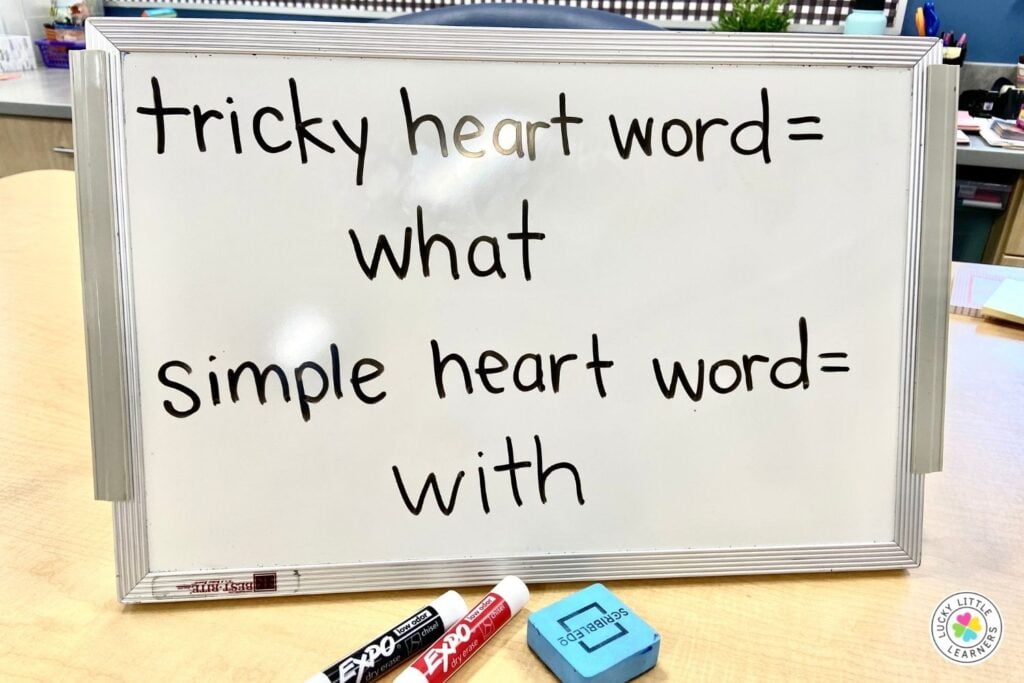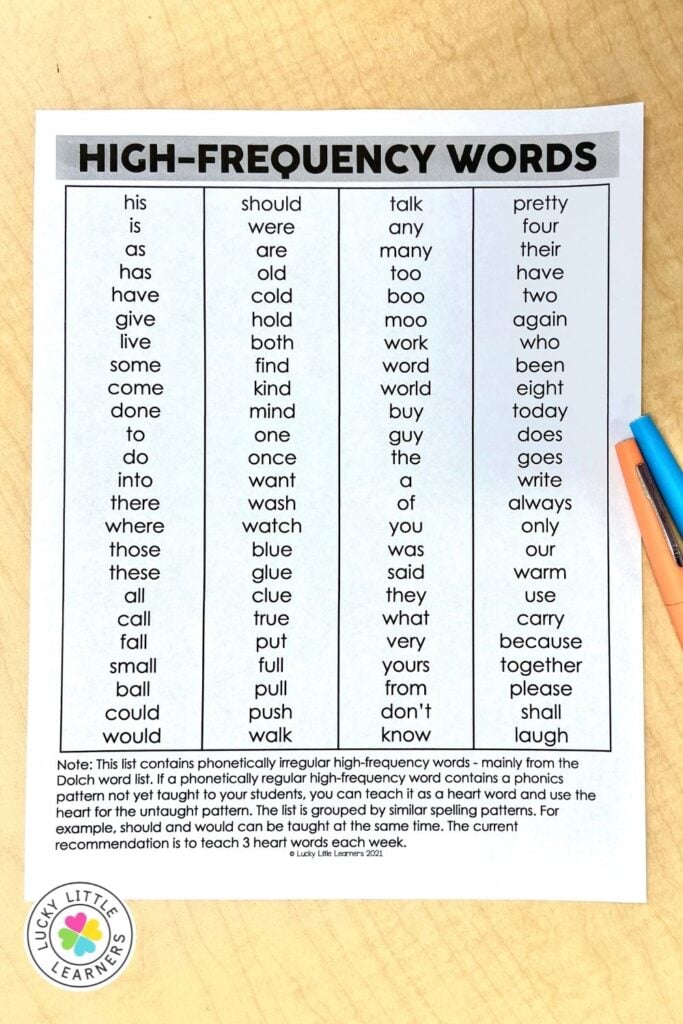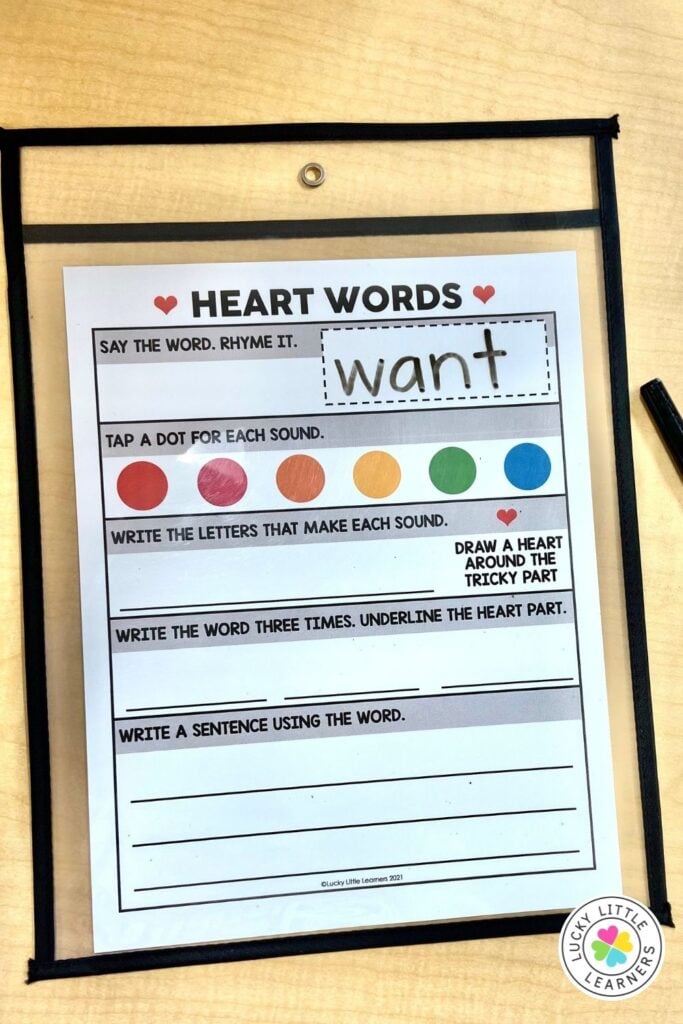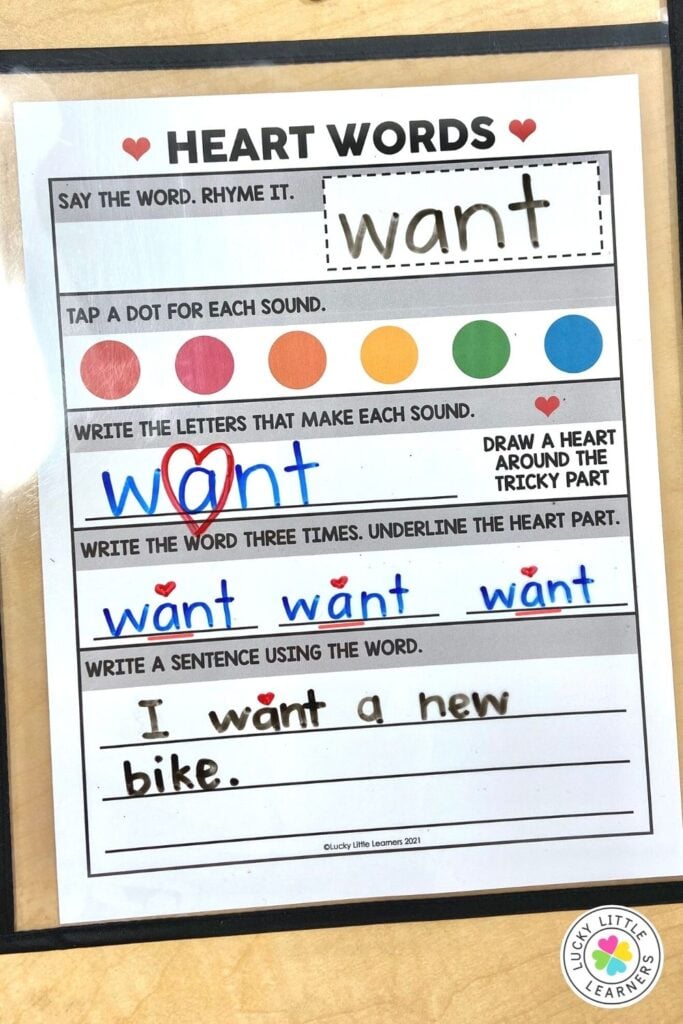I know you’re here to learn how to teach heart words but before we get into the nitty-gritty of how to let’s start with some basics. The term “heart words” is used to describe high-frequency words. They are words that we want our students to know by heart. If your school uses Dolch or Fry word lists- those are the words we’re talking about. A commonly quoted fact is that 100 common words make up 50% of what we read. So, helping our students gain automaticity when encountering high-frequency, or heart words, helps increase their fluency.

Understanding The Lingo
Some people use heart words, sight words, and high-frequency words interchangeably but that’s actually an incorrect use of the term sight words. For even more information about heart words visit this Really Great Reading post.
When learning about heart words you’ll probably encounter the terms “simple heart words,” “tricky heart words,” or “flash words.” That refers to how decodable the word is. For example, the word “what” has regular, initial, and final sounds but the medial /a/ makes an irregular sound. That’s a tricky heart word. In some places, the only words referred to as “heart words” are these tricky irregular words. The word “with” is a high-frequency word that students can decode once they have the necessary phonics skills. That makes it a simple heart word or a flash word.

Why Heart Words?
So, why should you change the way you teach high-frequency words? Heart words are science of reading (SOR) aligned. There are a lot of big shifts happening in reading instruction and high-frequency words are no exception.
Amazingly, 63% of the Dolch list is decodable! That last 27%, about 60ish words, need to be explicitly taught. Teaching students those tricky heart words is about relying on orthographic mapping instead of just rote memorization of the word as a whole. Learn more about orthographic mapping in this post.

2 Ways to Get This Resource
Join All Access to download everything we've ever made.

Or... Purchase the bundle in our shop.

How to Teach Heart Words
For all the high-frequency words that are decodable, explicitly teaching our students to connect phonemes and sounds give most students the tools they need to read them. This excellent post from Reading Rockets dives deep into the high-frequency words, which are decodable and what order they can be introduced in. If you want a student-friendly introduction video, Really Great reading has an excellent one.
Step 1: Introduce the Word
We’re going to start with some direct instruction. Introduce the word you’re working on during the lesson. Identify and count the sounds in the word. Have your students repeat after you. You can represent the sounds by simply tapping them out on the colored dots on the Heart Words page shown below. You can also use playdoh balls or colored squares. Focus on the sounds. If we use the word want as an example heart word, students would repeat the word “want” then tap out the 4 sounds in the word.
If you need a page to keep your heart word instruction structured check out the resources available in the Small Group & Intervention Literacy Kit.

Step 2: Build the Word
In this step, start building the word with you as you identify the regular sounds in the word. In our example, you can identify and write down (or build using magnets) the letters w, n, t.

Step 3: Mark the Heart Part
Discuss the part of the word that is irregular. On your heart word page, write down the letter(s) that make the irregular sounds and use a little heart symbol above the irregular section or draw a big heart around that section/letter. Whichever you prefer. The goal is simply to bring attention to the piece of the word that your students will have to know by heart!

Step 4: Practice!
Practice! Have students write their focus word on the included three lines and mark the “heart part.” There’s also a section to use their heart word in a sentence. Remind your students to keep marking the heart part to help focus their attention on the piece they’ll need to memorize.

Heart Word Practice Sheets
When students are ready for independent practice, try this collection of over 150 heart word practice sheets. (Perfect for morning work!)

More Science of Reading
If you’re working on ensuring that your reading instruction is science of reading aligned, we’ve got a lot of great and easy-to-understand information for you! Check out the posts below for more!
- Resources to Teach Science of Reading Components
- Spelling Activities for the Science of Reading Classroom
- Science of Reading Sample Literacy Block Schedule
Where to Buy Teaching Tools for the Heart Word Routine
2 Ways to Get This Resource
Join All Access to download everything we've ever made.

Or... Purchase the bundle in our shop.






Hello! What brand of the plastic sleeves did you use for the photos above? They look very sturdy. Thank you!
Hello Kerry! Here is a link to the plastic sleeves we recommend on Amazon. Have a great day!
I’m a retired elem. sch. teacher. For eleven yrs. I was a Title 1 reading teacher. Of course most of your methods/strategies are new to me i.e. terms such as heart words (but I DO understand “learn by heart”)
. At the top of the work page it says “rhyme it”. Yes, this is trivial, but does that mean think of a rhyming word? Right now I can’t think of a single word that rhymes with want. I’d appreciate an explanation. Sincerely, Mrs. “Glee-nuh” Lambert
Hello Glenna! The routine does in fact call for thinking of a rhyming word. This helps activate phonemic awareness of the sounds in the heart word. If there is not a word that rhymes (like with the word “want”), think of another way to activate phonemic awareness of the sounds in the word. For example, “what is another word that starts with /W/? What is another word that ends with /nt/?” I hope this helps!
font, jaunt, gaunt, haunt, croissant, restaurant, taunt, aunt, Vermont
Hi! Do you sell the Heart Word explanation sheet by it self? I’m looking for something to help parents understand how/why their kindergartners are learning words as Heart Words.
Hello Suzann! I’m sorry, we do not sell a stand alone parent explanation sheet to go with the heart words resource. Thanks for your comment!
Hi! How many heart words do you teach a week? Do you have a weekly routine you follow? Is this something you recommend doing whole group or small group? I teach grade 3 and a lot of my students would benefit from learning heart words, but I’m not sure where to fit it into my schedule or how much practice to give them each week. Thanks!
Hello Cassidy! We would recommend doing it as a warm up during small group in 3rd grade and working through a few a week. I hope this helps!
Hi there, I am about to introduce the heart word concept. When a child is reading a text they’ve never read and are adept at sounding out, what explanation should teachers give when the child comes across a word that makes no sense when sounding out e.g. do.
Hello Paula, Great question! The best way to handle this is to tell students the word and explain that part is irregular. So –
“The word is do. In this word, the o represents the /ooo/ sound.”